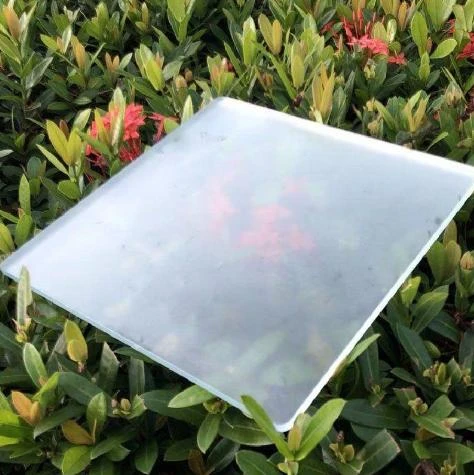The Role of Float Glass Plates in Modern Architecture and Industry
In contemporary construction and manufacturing, the float glass plate has emerged as a pivotal component. Its unique properties—clarity, durability, and versatility—contribute significantly to a range of applications, from architectural facades to high-tech electronics. Understanding what float glass is, how it is manufactured, and its myriad uses helps to appreciate its importance in today's world.
What is Float Glass?
Float glass is a type of flat glass produced by floating molten glass on top of molten tin. This method, pioneered in the 1950s, results in a smooth, uniform surface that is ideal for various applications. The process begins with the melting of raw materials such as silica sand, soda ash, and limestone at high temperatures. Once the mixture is molten, it is poured onto molten tin, where it spreads out and forms a thick, even sheet. As it cools, the glass solidifies into a flat plate, which can then be cut and processed further.
The term float glass derives from this unique manufacturing process, which yields superior optical quality and uniformity compared to other glass-making methods. The result is a transparent product that is less likely to distort images, making it highly desirable for applications requiring clarity, such as windows and display units.
Advantages of Float Glass Plates
Float glass offers numerous advantages. Its optical clarity allows for the unobstructed view and excellent light transmission, making it an ideal choice for windows and skylights. Moreover, float glass is highly resistant to weather conditions, withstanding both rain and UV light without degrading. This durability extends its application to structural use in buildings, where it can contribute to energy efficiency by minimizing heat transfer.
Additionally, float glass can be treated or coated to enhance its properties. For example, reflective coatings can be applied for aesthetic appeal and energy efficiency, reducing glare and solar heat gain during hot months. This versatility makes float glass a preferred material in green building practices, where sustainability is paramount.
float glass plate
Applications in Architecture
In modern architecture, float glass plates play a crucial role. They are prevalent in creating visually appealing facades, allowing for natural light to infiltrate interior spaces while maintaining a connection with the outside world. Glass curtain walls, often seen in skyscrapers, utilize large panels of float glass, which provides a sleek aesthetic while still being functional.
Moreover, the strength of float glass can be magnified through processes such as tempering or laminating. Tempered glass is heated and then rapidly cooled to enhance its strength, making it suitable for areas susceptible to breakage. Laminated glass, composed of two or more layers bonded with a plastic interlayer, enhances safety by preventing shattering upon impact.
Industrial Uses of Float Glass
Beyond construction, float glass has a broad range of applications in industries such as electronics and automotive manufacturing. In the electronics sector, float glass is utilized in the production of screens for televisions, smartphones, and other devices due to its high transparency and ability to be finely polished. The ceramics and optics industries also utilize float glass for lenses and mirrors, appreciating its precision and clarity.
In the automotive industry, float glass plates are used in the production of windshields and windows, where safety and durability are critical. Through advancements in glass technology, features such as heated panels or tinted options have become available, further expanding the utility of float glass in vehicles.
Conclusion
Float glass plates are a quintessential element in modern technology, architecture, and design. Their unique manufacturing process endows them with exceptional clarity and strength, making them indispensable in various applications. As the demand for sustainable and aesthetically pleasing materials continues to rise, float glass will undoubtedly remain at the forefront of innovation in both the construction industry and beyond. As we move into a more glass-centric world, understanding the significance of float glass plates is crucial for appreciating the advancements that shape our built environment.
 Afrikaans
Afrikaans  Albanian
Albanian  Amharic
Amharic  Arabic
Arabic  Armenian
Armenian  Azerbaijani
Azerbaijani  Basque
Basque  Belarusian
Belarusian  Bengali
Bengali  Bosnian
Bosnian  Bulgarian
Bulgarian  Catalan
Catalan  Cebuano
Cebuano  Corsican
Corsican  Croatian
Croatian  Czech
Czech  Danish
Danish  Dutch
Dutch  English
English  Esperanto
Esperanto  Estonian
Estonian  Finnish
Finnish  French
French  Frisian
Frisian  Galician
Galician  Georgian
Georgian  German
German  Greek
Greek  Gujarati
Gujarati  Haitian Creole
Haitian Creole  hausa
hausa  hawaiian
hawaiian  Hebrew
Hebrew  Hindi
Hindi  Miao
Miao  Hungarian
Hungarian  Icelandic
Icelandic  igbo
igbo  Indonesian
Indonesian  irish
irish  Italian
Italian  Japanese
Japanese  Javanese
Javanese  Kannada
Kannada  kazakh
kazakh  Khmer
Khmer  Rwandese
Rwandese  Korean
Korean  Kurdish
Kurdish  Kyrgyz
Kyrgyz  Lao
Lao  Latin
Latin  Latvian
Latvian  Lithuanian
Lithuanian  Luxembourgish
Luxembourgish  Macedonian
Macedonian  Malgashi
Malgashi  Malay
Malay  Malayalam
Malayalam  Maltese
Maltese  Maori
Maori  Marathi
Marathi  Mongolian
Mongolian  Myanmar
Myanmar  Nepali
Nepali  Norwegian
Norwegian  Norwegian
Norwegian  Occitan
Occitan  Pashto
Pashto  Persian
Persian  Polish
Polish  Portuguese
Portuguese  Punjabi
Punjabi  Romanian
Romanian  Russian
Russian  Samoan
Samoan  Scottish Gaelic
Scottish Gaelic  Serbian
Serbian  Sesotho
Sesotho  Shona
Shona  Sindhi
Sindhi  Sinhala
Sinhala  Slovak
Slovak  Slovenian
Slovenian  Somali
Somali  Spanish
Spanish  Sundanese
Sundanese  Swahili
Swahili  Swedish
Swedish  Tagalog
Tagalog  Tajik
Tajik  Tamil
Tamil  Tatar
Tatar  Telugu
Telugu  Thai
Thai  Turkish
Turkish  Turkmen
Turkmen  Ukrainian
Ukrainian  Urdu
Urdu  Uighur
Uighur  Uzbek
Uzbek  Vietnamese
Vietnamese  Welsh
Welsh  Bantu
Bantu  Yiddish
Yiddish  Yoruba
Yoruba  Zulu
Zulu 

